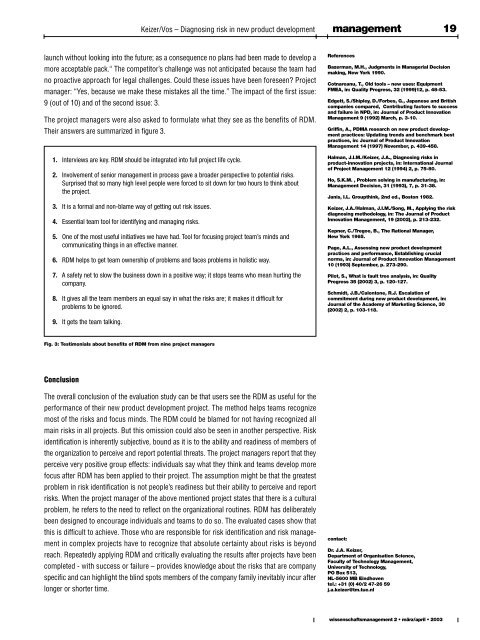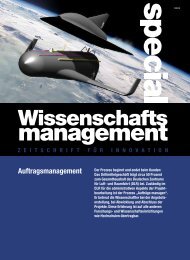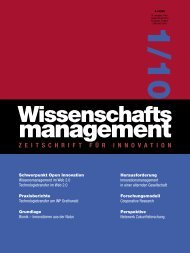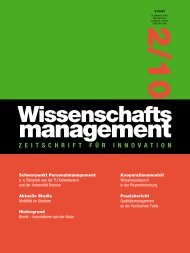Heft 2/2003 - Lemmens Medien GmbH
Heft 2/2003 - Lemmens Medien GmbH
Heft 2/2003 - Lemmens Medien GmbH
Erfolgreiche ePaper selbst erstellen
Machen Sie aus Ihren PDF Publikationen ein blätterbares Flipbook mit unserer einzigartigen Google optimierten e-Paper Software.
Keizer/Vos – Diagnosing risk in new product development management 19<br />
launch without looking into the future; as a consequence no plans had been made to develop a<br />
more acceptable pack.“ The competitor’s challenge was not anticipated because the team had<br />
no proactive approach for legal challenges. Could these issues have been foreseen? Project<br />
manager: “Yes, because we make these mistakes all the time.” The impact of the first issue:<br />
9 (out of 10) and of the second issue: 3.<br />
The project managers were also asked to formulate what they see as the benefits of RDM.<br />
Their answers are summarized in figure 3.<br />
1. Interviews are key. RDM should be integrated into full project life cycle.<br />
2. Involvement of senior management in process gave a broader perspective to potential risks.<br />
Surprised that so many high level people were forced to sit down for two hours to think about<br />
the project.<br />
3. It is a formal and non-blame way of getting out risk issues.<br />
4. Essential team tool for identifying and managing risks.<br />
5. One of the most useful initiatives we have had. Tool for focusing project team’s minds and<br />
communicating things in an effective manner.<br />
6. RDM helps to get team ownership of problems and faces problems in holistic way.<br />
7. A safety net to slow the business down in a positive way; it stops teams who mean hurting the<br />
company.<br />
8. It gives all the team members an equal say in what the risks are; it makes it difficult for<br />
problems to be ignored.<br />
9. It gets the team talking.<br />
Fig. 3: Testimonials about benefits of RDM from nine project managers<br />
Conclusion<br />
The overall conclusion of the evaluation study can be that users see the RDM as useful for the<br />
performance of their new product development project. The method helps teams recognize<br />
most of the risks and focus minds. The RDM could be blamed for not having recognized all<br />
main risks in all projects. But this omission could also be seen in another perspective. Risk<br />
identification is inherently subjective, bound as it is to the ability and readiness of members of<br />
the organization to perceive and report potential threats. The project managers report that they<br />
perceive very positive group effects: individuals say what they think and teams develop more<br />
focus after RDM has been applied to their project. The assumption might be that the greatest<br />
problem in risk identification is not people’s readiness but their ability to perceive and report<br />
risks. When the project manager of the above mentioned project states that there is a cultural<br />
problem, he refers to the need to reflect on the organizational routines. RDM has deliberately<br />
been designed to encourage individuals and teams to do so. The evaluated cases show that<br />
this is difficult to achieve. Those who are responsible for risk identification and risk management<br />
in complex projects have to recognize that absolute certainty about risks is beyond<br />
reach. Repeatedly applying RDM and critically evaluating the results after projects have been<br />
completed - with success or failure – provides knowledge about the risks that are company<br />
specific and can highlight the blind spots members of the company family inevitably incur after<br />
longer or shorter time.<br />
References<br />
Bazerman, M.H., Judgments in Managerial Decision<br />
making, New York 1990.<br />
Cotnareanu, T., Old tools – new uses: Equipment<br />
FMEA, in: Quality Progress, 32 (1999)12, p. 48-53.<br />
Edgett, S./Shipley, D./Forbes, G., Japanese and British<br />
companies compared, Contributing factors to success<br />
and failure in NPD, in: Journal of Product Innovation<br />
Management 9 (1992) March, p. 3-10.<br />
Griffin, A., PDMA research on new product development<br />
practices: Updating trends and benchmark best<br />
practices, in: Journal of Product Innovation<br />
Management 14 (1997) November, p. 439-458.<br />
Halman, J.I.M./Keizer, J.A., Diagnosing risks in<br />
product-innovation projects, in: International Journal<br />
of Project Management 12 (1994) 2, p. 75-80.<br />
Ho, S.K.M. , Problem solving in manufacturing, in:<br />
Management Decision, 31 (1993), 7, p. 31-38.<br />
Janis, I.L. Groupthink, 2nd ed., Boston 1982.<br />
Keizer, J.A./Halman, J.I.M./Song, M., Applying the risk<br />
diagnosing methodology, in: The Journal of Product<br />
Innovation Management, 19 (2002), p. 213-232.<br />
Kepner, C./Tregoe, B., The Rational Manager,<br />
New York 1965.<br />
Page, A.L., Assessing new product development<br />
practices and performance, Establishing crucial<br />
norms, in: Journal of Product Innovation Management<br />
10 (1993) September, p. 273-290.<br />
Pilot, S., What is fault tree analysis, in: Quality<br />
Progress 35 (2002) 3, p. 120-127.<br />
Schmidt, J.B./Calontone, R.J. Escalation of<br />
commitment during new product development, in:<br />
Journal of the Academy of Marketing Science, 30<br />
(2002) 2, p. 103-118.<br />
contact:<br />
Dr. J.A. Keizer,<br />
Department of Organisation Science,<br />
Faculty of Technology Management,<br />
University of Technology,<br />
PO Box 513,<br />
NL-5600 MB Eindhoven<br />
tel.: +31 (0) 40/2 47-26 59<br />
j.a.keizer@tm.tue.nl<br />
wissenschaftsmanagement 2 • märz/april • <strong>2003</strong>

















